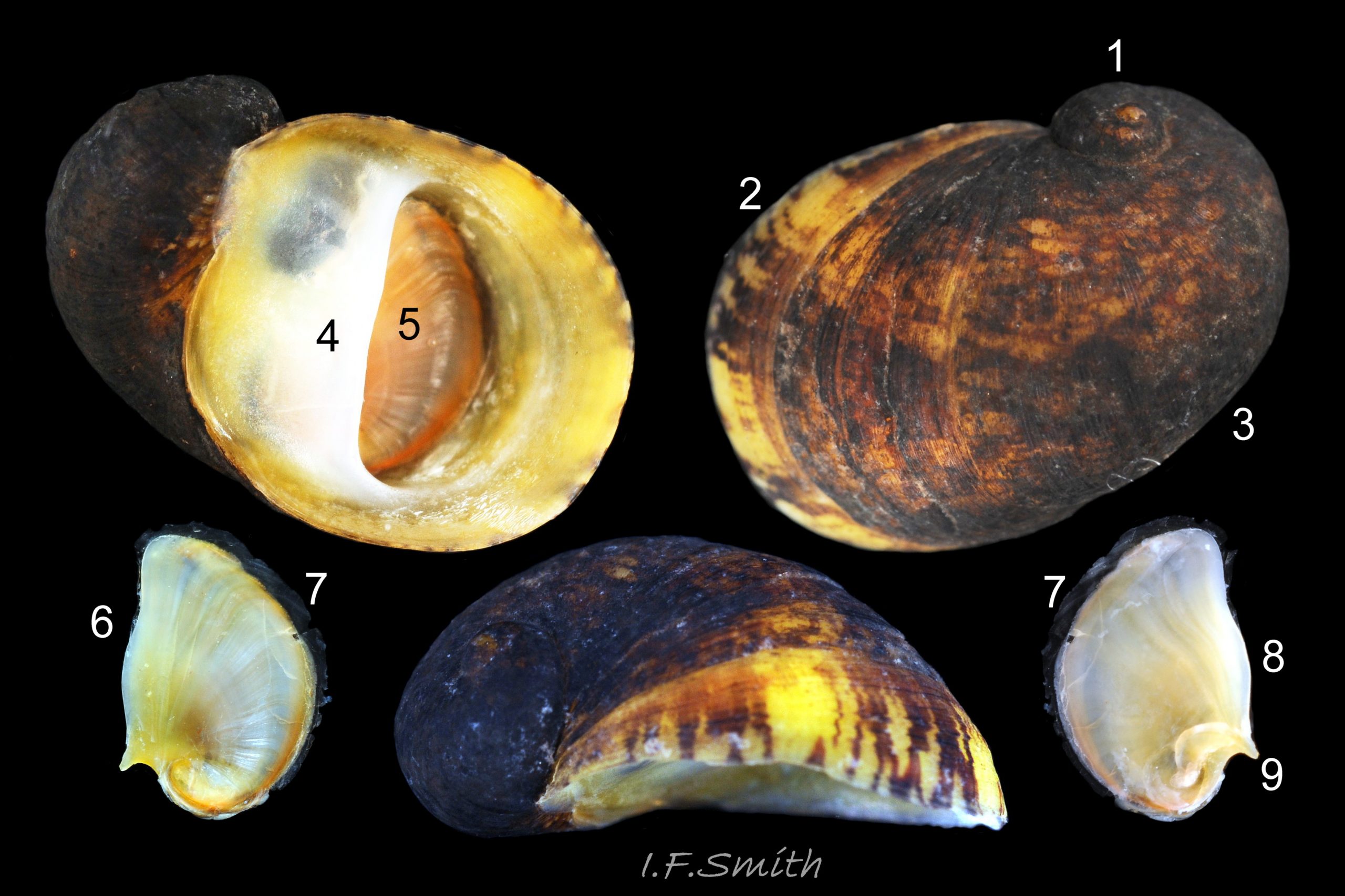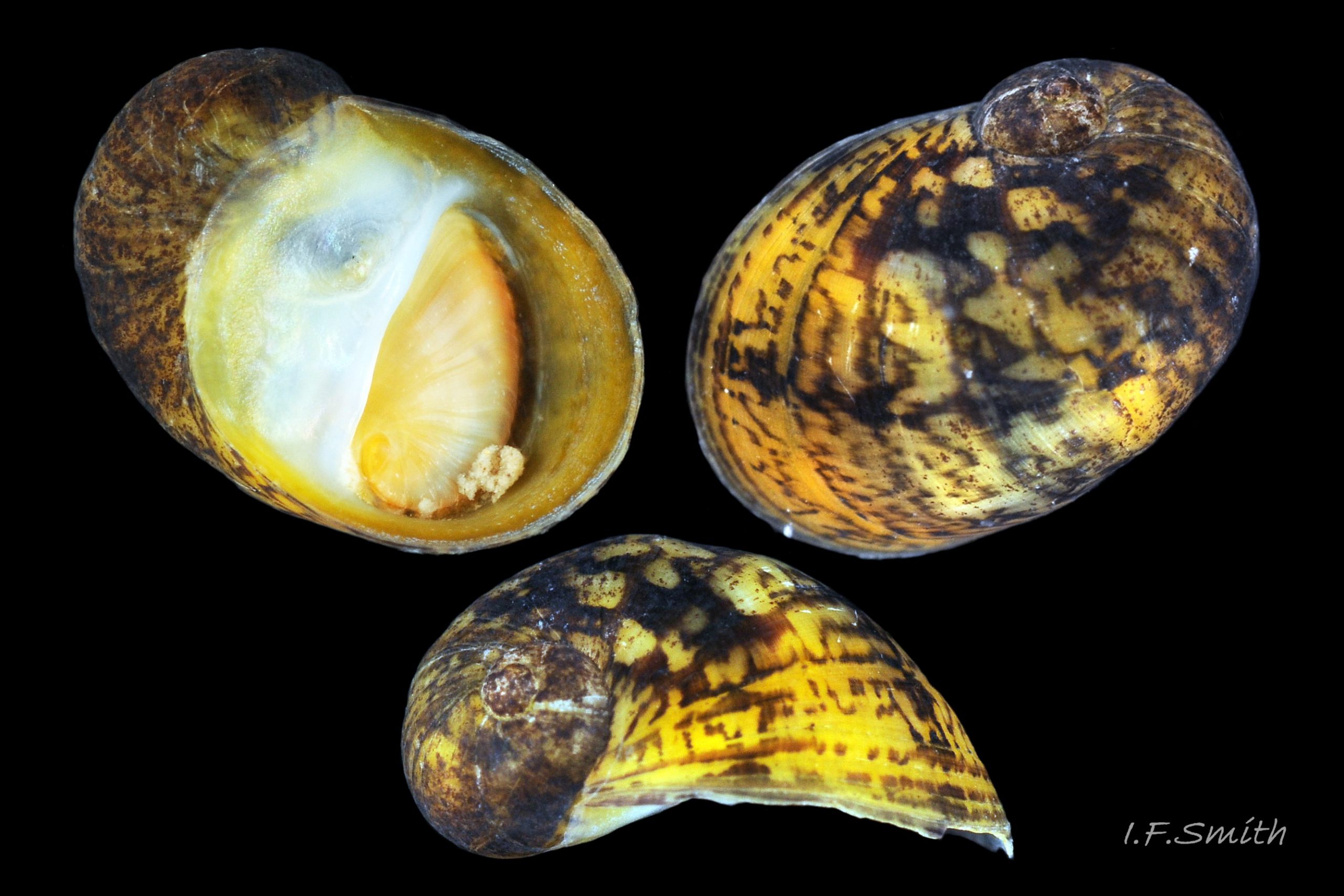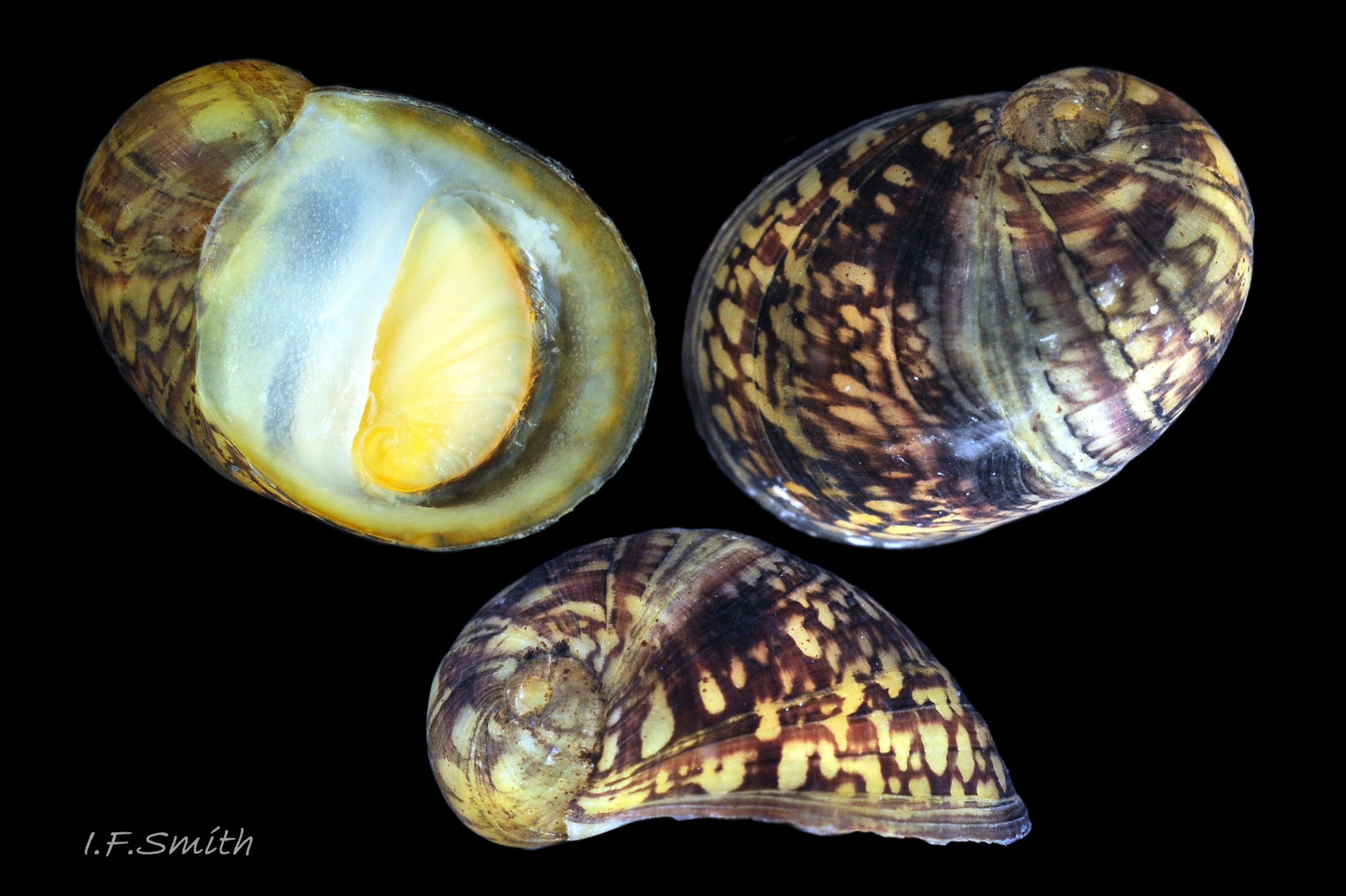Click image to enlarge with full caption. Main text below slider.
Theodoxus fluviatilis (Linnaeus, 1758)
Synonyms: Nerita fluviatilis Linnaeus, 1758; Neritina fluviatilis (Linnaeus, 1758 ); Nerita littoralis Linnaeus, 1758; Nerita lacustris Linnaeus, 1758;
Vernacular: River nerite
GLOSSARY below.
Shell description.
Usual length to 11mm. Most of shell consists of hemispherical body whorl. Spire of two whorls, very small but distinct with well defined sutures, but often eroded (image M. Maňas) flic.kr/p/pLWdPd on older specimens if calcium carbonate content of water is below optimum. Only sculpture is fine growth lines. Aperture D-shaped, occupies about 75% of ventral face. Inner lip expanded into wide, white or yellow, shelf like septum covering about 40% of aperture 01 Theodoxus fluviatalis. Palatal (outer) lip thin. Smooth exterior, with slight sheen, is white or yellowish with extremely varied brown, black 02 Theodoxus fluviatalis, purple, violet 03 Theodoxus fluviatalis or pinkish markings, often reticulate or forming zig zags, blotches or hieroglyph like marks. Majority of some populations are heavily encrusted with black/brown alga or minerals 01 Theodoxus fluviatalis. Internally dull yellowish. D shaped operculum consists of thick proximal calcareous layer that adheres to foot and is further secured by a strong hooked peg embedded into the foot, and a thin distal layer of conchiolin that extends beyond the rigid calcareous layer to form a flexible seal around the edges of the operculum when closed.
Images of live animals: by other Flickr members:
Michal Maňas flic.kr/p/oQ4ccHflic.kr/p/pLRBpgflic.kr/p/pLBXFTflic.kr/p/pJLhT1flic.kr/p/pLVTHs
Brian Eversham flic.kr/p/eaaTcN
Habits and ecology
Obligatory calcicole species (Boycott,1936) living on hard substrate in lime rich water in rivers, freely flowing canals and large lakes with appreciable wave action, in lowlands; significantly unrecorded from upland limestone of Derbyshire, England. Also in brackish water, generally to salinity 2.5‰, but up to 17‰; abundant in parts of Baltic Sea, also in Black Sea, the Netherlands and a brackish loch in Orkney, aerial image at www.google.co.uk/maps/@59.0020569,-3.2192657,11600m/data=… . Linnaeus named three forms of Theodoxus fluviatilis as separate species according to their habitats; Nerita fluviatilis (river), N. lacustris (lake) and N. littoralis (seashore). These names are sometimes added to form subspecies names. For two centuries the “littoralis” name was mistakenly used in the form Littorina littoralis by many for Littorina obtusata sensu lato 03 Theodoxus fluviatalis. Spawns April to October. Depressed spherical, yellow or whitish egg capsules, with equatorial suture, attached to rock, wood, shells of other individuals and, sometimes, plants (image, B. Eversham) flic.kr/p/egw7ow . Matt surface of capsule coated with fine layer of sand grains and diatom cases from the crystal sac which accumulates them from rectum. Each capsule contains several ova; c. 140 in freshwater, c. 50 in brackish water, but one snail emerges (no planktonic veliger) having used the other ova as food over 30 to 60 days. After emergence, lower half of capsule may remain (image M. Maňas) flic.kr/p/pLWdPd . Lifespan 2 or 3 years. Although mainly an inhabitant of freshwater, Theodoxus fluviatilis is allied to typical marine gastropods in having an operculum 01 Theodoxus fluviatalis and ctenidium (gill) (image M. Maňas) flic.kr/p/pJLgry .
Distribution and status
Most of lowland western Europe from Baltic (about 60ºN) to Mediterranean and Black Sea GBIF map www.gbif.org/species/2291444 . Widespread in Ireland. In Britain confined to lowland England with a few records in lowland Wales and two sites in Scotland UK map NBN species.nbnatlas.org/species/NBNSYS0000006601#tab_mapView
Acknowledgements
I wish to thank Simon Taylor, Marine Recorder for the Conchological Society of G.B. and Ireland, for helpful discussion and the provision of specimens and photographs. Michal Maňas and Brian Eversham are thanked for access to their images of live Theodoxus fluviatilis.
Links and references
Boycott, A.E. 1936. The habitats of freshwater mollusca in Britain. J. animal Ecol.5 116 to 186.
Forbes, E. & Hanley S. 1849-to 53. A history of the British mollusca and their shells. vol. 3 (1853), London, van Voorst. As Neritina fluviatilis; Free pdf at www.biodiversitylibrary.org/item/46371#page/18/mode/1up p2 to 6
Fretter, V. and Graham, A. 1962. British prosobranch molluscs: their functional anatomy and ecology. Ray Society, London. (Has index of species.)
Fretter, V. and Graham, A. 1994. British prosobranch molluscs: their functional anatomy and ecology. Revised edition. Ray Society, London. (Much new material but lacks index of species.)
Graham, A. 1988. Prosobranch and pyramidellid gastropods. Linnean Synopsis No.2 (Second Edition). Brill & Backhuys, Leiden.
Jeffreys, J.G. 1862-to 69. British conchology. vol. 1 (1862). van Voorst, London. As Neritina fluviatilis; Free pdf at . www.biodiversitylibrary.org/item/63190#page/178/mode/1up p52 to 55
Kebapçı, U. & Van Damme, D. 2012. Theodoxus fluviatilis. The IUCN Red List of Threatened Species 2012: e.T165352A1081028. dx.doi.org/10.2305/IUCN.UK.2012-1.RLTS.T165352A1081028.en. Downloaded on 06 January 2017.
Kerney, M. 1999. Atlas of the land and freshwater molluscs of Britain and Ireland. Harley Books, Great Horkesley, Colchester.
Maňas, M. accessed Jan. 2017. Blog about gastropods: text and images of T. fluviatilis.
gastropods.wordpress.com/2014/10/23/photo-of-the-day-34-t…
Pfleger, V. 1998. A field guide in colour to molluscs. Aventinum, Prague, Czech Republic.
Wikipedia, accessed January 2017. en.wikipedia.org/wiki/Theodoxus_fluviatilis
Current taxonomy: World Register of Marine Species (WoRMS) www.marinespecies.org/aphia.php?p=taxdetails&id=153558
Glossary
adapical = towards the apex of the shell.
aperture = mouth of gastropod shell; outlet for head and foot.
auct. (abbreviation of “auctorum”; “of authors”) = name, often of another valid sp., used in error for this one by other author(s). en.wikipedia.org/wiki/Auctorum
calcicole = species that thrives best in lime rich conditions.
calcicole, obligatory = species that requires lime rich conditions to survive and reproduce.
cephalic (adj.) = of or on the head.
cilia (pl.) = vibrating linear extensions of membrane used in feeding or locomotion. (“cilium” singular).
ciliated = (adj.) coated with cilia.
columella = solid or hollow axial “little column” around which gastropod shell spirals; hidden inside shell, except on final whorl next to lower part of inner lip of aperture where hollow ones may end in an umbilicus or siphonal canal.
columellar (adj.)= of or near central axis of spiral gastropod.
columellar lip = lower (abapical) part of inner lip of aperture.
crystal sac (in Theodoxus) = small receptacle adjacent to terminal opening of oviduct for storing sand grains and diatom cases from rectum until needed for coating sticky egg capsules as they emerge from oviduct.
ctenidium = comb-like molluscan gill; usually an axis with a row of filaments either side.
diatom = microscopic aquatic alga with siliceous cell-walls.
height = (of gastropod shells) distance from apex of spire to base of aperture.
mantle = sheet of tissue that secretes the shell and forms a cavity for the gill in most marine molluscs.
opercular (adj.) = of the operculum.
opercular disc = part of foot that growing operculum rotates on.
opercular lobe = extension of opercular disc round edge of part of operculum.
operculum = plate of horny conchiolin, rarely calcareous, used to close shell aperture.
suture = groove or line where whorls of gastropod shell adjoin, or joint line on other items, such as egg capsules.
sensu lato (abbreviation s.l.) = in the wide sense, possibly an aggregate of more than one species.
veliger = shelled larva of marine gastropod or bivalve mollusc which swims by beating cilia of a velum (bilobed flap). Stage may be passed in plankton or within liquid-filled egg-capsule.



